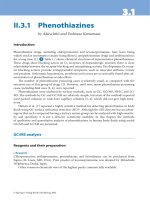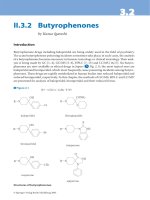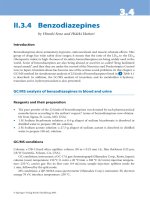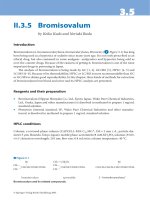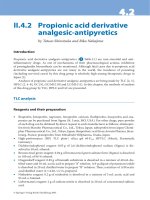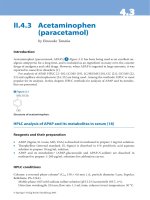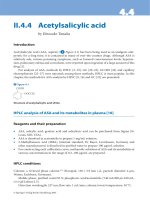Tài liệu Drugs and Poisons in Humans - A Handbook of Practical Analysis (Part 33) doc
Bạn đang xem bản rút gọn của tài liệu. Xem và tải ngay bản đầy đủ của tài liệu tại đây (328.39 KB, 10 trang )
4.14.1
© Springer-Verlag Berlin Heidelberg 2005
II.4.1 Diphenylmethane
antihistaminics
by Yoko Hieda and Kojiro Kimura
Introduction
Diphenylmethane antihistaminics are being widely used for treatments of allergy, motion
(travel) sickness and cold. ey are also being sold as over-the-counter drugs. e structures of
principal drugs of this group are shown in
> Figure 1.1. ey are being analyzed by GC [1–6]
and HPLC [7–13]. In this chapter, a GC method for simultaneous analysis of diphenylmethane
antihistaminics and also HPLC methods for some representative drugs of this group are pre-
sented.
Simultaneous analysis by GC [4]
Reagents and their preparation
• Diphenhydramine hydrochloride, diphenylpyraline hydrochloride, phenyltoloxamine
citrate, orphenadrine hydrochloride, benactyzine hydrochloride, doxylamine succinate,
carbinoxamine maleate, chlorpheniramine maleate, triprolidine hydrochloride, homo-
chlorcyclizine dihydrochloride, hydroxyzine dihydrochloride, clemastine fumarate and
meclizine dihydrochloride can be purchased from Sigma (St. Louis, MO, USA). Pure
powder of terodiline hydrochloride and piperilate hydrochloride was donated by
Kissei Pharmaceutical Co., Ltd., Nagano, Japan and Nippon Shinyaku Co., Ltd., Kyoto,
Japan, respectively. Sep-Pak C
18
cartridges (classic type) were purchased from Waters
(Milford, MA, USA). Other common chemicals were of the highest purity commercially
available.
• Care should be taken for that all of the above 15 kinds of drugs are in the salt forms. All
compounds (5-mg each as the weight of its free base) are altogether dissolved in methanol
to prepare 10 mL solution; a 10-µL volume of the mixture solution is spiked into 1 mL of
whole blood or urine. One of the 15 drugs is selected for use as internal standard (IS).
• Chloroform/methanol (9:1) and distilled water, 100–200 mL each, are prepared.
• 0.5 M NaHCO
3
solution: a 4.2-g aliquot of NaHCO
3
is dissolved in distilled water to pre-
pare 100 mL solution.
GC conditions
GC column
a
: DB-1 (15 m × 0.32 mm i. d., lm thickness 1.0 µm), DB-17 (15 m × 0.32 mm
i. d., lm thickness 0.25 µm) both obtained from J & W Scienti c (Folsom, CA, USA).
316 Diphenylmethane antihistaminics
GC conditions: an HP 5890 Series II gas chromatograph
b
(Agilent Technologies, Palo Alto,
CA, USA); detector: FID; column temperatures: 160 °C (1 min) →5 °C/min →290 °C for the
DB-1 column, and 160 °C (1 min) →5 °C/min →280 °C for the DB-17 column; injection tem-
perature: 240 °C; detection temperature: 280 °C; carrier gas: He; its ow rate: 3 mL/min; a 1-µL
aliquot of sample solution is injected into GC in the splitless mode (1 min), followed by the
split mode at 160 °C of oven temperature.
Structures of principal diphenylmethane antihistaminics.
⊡ Figure 1.1
317
Procedure
i. A 10-mL volume of methanol and 10 mL distilled water are passed through a Sep-Pak C
18
cartridge
c
for its activation.
ii. A 10-µL aliquot of methanolic solution of a suitable IS
d
(in case of simultaneous analysis of
spiked drugs, 5 µg each in the 10 µL solution) is added to 1 mL whole blood, and mixed
well with 9 mL distilled water for complete hemolysis. To this mixture, 5 mL of 0.5 M NaH-
CO
3
solution is added to make it slightly alkaline. To 1-mL volume of a urine specimen, a
10-µL aliquot of the IS solution, 4 mL distilled water and 5 mL of 0.5 M NaHCO
3
solution
are added.
iii. Either mixture of whole blood or urine specimen is poured
e
into the activated cartridge
with a ow rate not faster than 5 mL/min using a 10-mL volume glass syringe.
iv. e cartridge is washed with 10 mL distilled water, and the target compounds are slowly
eluted with 3 mL of chloroform/methanol (9:1) into 4-mL volume glass vial.
v. A small amount of the upper aqueous phase of the eluate is carefully removed with a Pas-
teur pipette; the lower organic phase is evaporated to dryness under a stream of nitrogen.
e residue is dissolved in 100 µL methanol, and a 1-µL aliquot of it is injected into GC.
For quantitation, the peak area ratio of a target compound to IS is obtained.
vi. For quantitative analysis, a 10-µL of IS solution and one of various concentrations of a
target compound are added to 1 mL of blank whole blood or urine obtained from healthy
subjects; at least 4 vials containing di erent concentrations of the compound should be
prepared. ese vials are processed according to the above procedure and analyzed by GC.
e calibration curve consists of peak area ratio of a target compound to IS on the vertical
axis and the concentration of a target compound on the horizontal axis. e peak area ratio
obtained at the step v is applied to the calibration curve to obtain the concentration.
Assessment and some comments on the method
> Figure 1.2 shows gas chromatograms for the authentic diphenylmethane antihistaminics
and for extracts of whole blood and urine in the presence and absence of 5 µg each of drugs per
1 mL obtained by the present method using a DB-1 capillary column. Many compounds ap-
peared as sharp peaks. With an intermediately polar DB-17 capillary column, sharp peaks also
appeared. By using both DB-1 and DB-17 columns, most compounds can be separated with
sharp peaks; however phenyltoloxamine and orphenadrine (peaks 3 and 4) could not be sepa-
rated with either column. With the DB-1 column, the peak of triprolidine (peak 9) overlapped
an impurity peak of whole blood and urine extracts, and the peak of chlorpheniramine (peak
6) overlapped a small impurity peak of the whole blood extract. ese problems could be over-
come by using the DB-17 column.
e recoveries of the drugs from human whole blood were not lower than 90 % except for
meclizine; the latter shows 49.4 % recovery. e recoveries of the drugs from urine were also
not lower than 90 % except benactyzine, piperilate and meclizine; those of the latter drugs were
64.6, 72.2 and 79.8 %, respectively.
e detection limits for diphenylmethane antihistaminics using the capillary GC method
are 0.2–0.5 µg/mL. To enhance sensitivity and speci city, GC/MS can be used; however, for
most compounds, molecular or quasi-molecular peaks are missing in the positive EI mode [4]
Simultaneous analysis by GC
318 Diphenylmethane antihistaminics
Capillary gas chromatograms for diphenylmethane antihistaminics extracted from whole blood and urine [4].
⊡ Figure 1.2
319
except for terolidine and triprolidine. For the latter compounds, relatively intense molecular
ions appear to be used for sensitive detection. In the positive and negative CI modes, intense
quasi-molecular ions appear for most drugs, which can be used for sensitive quantitation.
HPLC analysis of diphenyhydramine in blood and urine [7]
Diphenhydramine is one of the most popular drugs in this group, and its poisoning cases
are many. In this section, one of the most common method by HPLC for diphenyldramine is
described.
Reagents and their preparation
• Diphenhydramine hydrochloride and imipramine hydrochloride can be obtained from
Sigma.
• IS: imipramine hydrochloride is dissolved in distilled water to prepare 0.5 µg/mL solu-
tion.
• Extraction solutions: hexane/isopropanol (98:2, v/v), saturated potassium carbonate aque-
ous solution and 0.5 % (v/v) phosphoric acid solution.
HPLC conditions
An HPLC system includes a usual conveying pump, an injector and a UV detector. Column:
reversed phase ODS-1 Spherisorb (15 cm × 0.46 cm i. d., particle diameter 5 µm); mobile
phase: acetonitrile/distilled water/1 M sodium dihydrogenphosphate solution (11:7:2, v/v); its
ow rate: 1.8 mL/min: detection wavelength: 205 nm.
Procedure
i. To 1 mL of serum or urine, 100 µL of IS solution and 200 µL of saturated potassium car-
bonate solution are added and extracted with hexane/isopropanol (98:2, v/v) by shaking.
ii. To the organic phase, 100 µL of phosphoric acid solution for back-extraction of the com-
pounds. An aliquot of the aqueous phase is injected into HPLC.
Assessment of the method
e retention times of diphenyhydramine and IS were 4.6 and 6.4 min, respectively. Linearity
could be obtained in the range of 1–100 ng/mL; the detection limit was reported to be 1 ng/mL.
HPLC analysis of diphenyhydramine in blood and urine
